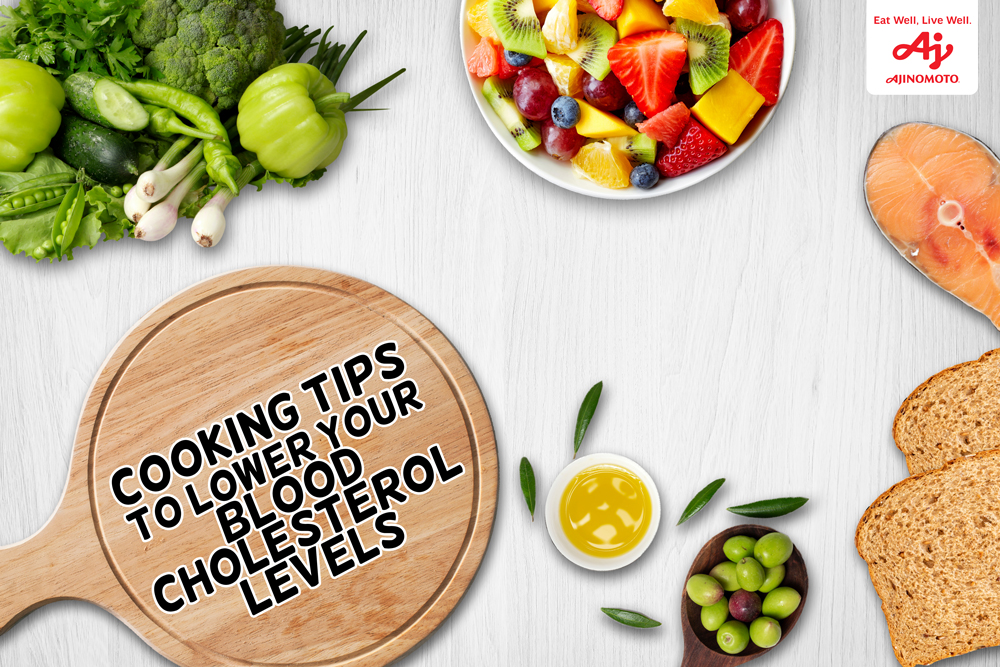Cooking Tips to Lower your Blood Cholesterol Levels
March 8, 2021 | 10:00 am

A low fat and low cholesterol eating plan can help you manage your blood cholesterol levels. It may also help you reduce your risk of developing heart diseases or stroke. The simple cooking tips below can help you prepare a delicious, low fat, low cholesterol meals that could help you have better heart health.
1. Use liquid vegetable oils instead of solid fats when cooking.
-
- Vegetable oils include canola oil, safflower oil, sunflower oil, corn oil, soybean oil, olive oil and etc. These contain good fats that help improve HDL levels in the body.
- Limit using solid fats such as lard, butter, shortening and hydrogenated fats.
2. Reduce saturated fat in meats and poultry.
-
- Select lean cuts of meat with little visible fat.
- Trim all visible fat from meat before cooking.
- Choose to broil, pan-broil, roast, bake, grill or pan-grill meats and poultry instead of pan-frying.
- Use a rack to drain off fat when broiling, roasting, or baking. Instead of basting with fat drippings, keep meat moist with wine, fruit juices or heart-healthy marinades.
- Roast meats at low temperature to allow more fat to come out of the meat.
- Poach or cook eggs in the shell in simmering water instead of frying.
- Remove the skin from the chicken before cooking. If the chicken dries out too much, try basting with wine, fruit juices or a heart-healthy oil-based marinade. Or leave the skin on for cooking and then remove it before eating.
3. Cook vegetables in little fat.
-
- Try cooking vegetables in little amount of oil and add a little amount of water, if needed.
- Explore steaming and baking vegetables.
4. Cook ahead.
-
- Stews, boiled meat, soup stock or other dishes in which fat cooks into the liquid can be refrigerated. Once the fat solidifies on top, removed the hardened fat.
- When doing sauces of gravies, let your liquid cool, then remove the hardened fat before making the gravy.
5. Increase fiber and whole grains in recipes.
-
- Toast and crush or cube fibre-rich whole grain bread to make breadcrumbs, stuffing or croutons.
- Serve whole fruit at breakfast in place of juice
- Add oats, whole grains, nuts, seeds, beans, fruits and vegetables to your daily meals. These are rich in soluble fibre which helps prevent the cholesterol from entering the bloodstream and travel to other parts of the body. With the help of soluble fibre from these food items, excess cholesterol will be excreted from the body through feces. As you increase your fibre intake, also increase your water intake. This will help to reduce your risk of becoming constipated.
-
- Stews, boiled meat, soup stock or other dishes in which fat cooks into the liquid can be refrigerated. Once the fat solidifies on top, removed the hardened fat.
- When doing sauces of gravies, let your liquid cool, then remove the hardened fat before making the gravy.
Though there are some restrictions in meals when trying to reduce blood cholesterol levels, low fat and low cholesterol meals need not to be bland and boring. Try our Grilled Cream Dory with Mango and Avocado Salsa Bowl recipe made with AJI-GINISA® Flavor Seasoning Mix. This dish includes avocados which are good sources of monounsaturated fatty acids that help in increasing HDL (the good cholesterol) in the body when consumed in moderate amounts. The mangoes, on the other hand, give you a refreshing and fruity taste that goes well with your Grilled Cream Dory. More so, AJI-GINISA® makes this dish more flavorful by giving the “Gisa” and umami taste that we love!
Good to Know Nutrition Facts!
Creamy Dory is rich in Omega 3 Fatty acids which help the heart beat at a steady phase and prevent potentially fatal erratic rhythm.
Disclaimer:
This article contains general information about exercise, fitness, diet, nutrition and related subjects intended for general educational purposes only. The words and other content provided in this material, and in any linked or referenced materials, are not intended and should not be construed as a health, medical, fitness, diet or nutrition advice. Always consult with a licensed physician and/or health workers before beginning any exercise, fitness, diet or nutrition routine especially if the reader is pregnant or having a special medical condition. Information presented herein, are in no way intended to substitute formal and legitimate consultations with your healthcare providers.
The views expressed on this blog and website have no relation to those of any academic or organizations mentioned as reference in this article.
References:
American Heart Association. Cooking to Lower Cholesterol. November 11, 2020. Retrieved from https://www.heart.org/en/health-topics/cholesterol/prevention-and-treatment-of-high-cholesterol-hyperlipidemia/cooking-to-lower-cholesterol
Food and Nutrition Research Institute-Department of Science and Technology (FNRI-DOST). 2008. Nutritional Guidelines for the Prevention of Heart Diseases and Diabetes Mellitus. FNRI Bldg., DOST Compound, Bicutan, Taguig City, Metro Manila, Philippines

Deborah S. Fajarda, RND is a licensed nutritionist-dietitian handling the Science Communication Section of AJINOMOTO PHILIPPINES CORPORATION’s Public Relations Department. She is a technical expert in food and health and an experienced Culinary Nutrition spokesperson.
Latest Blogs
Cooking Tips to Lower your Blood Cholesterol Levels
March 8, 2021
Things You Find in Every Pinoy Birthday Handaan List
February 15, 2021
A Private Mukbang Sesh for 2
February 11, 2021
Breakfast in Bed
February 10, 2021
RELATED ARTICLES
A low fat and low cholesterol eating plan can help you manage your blood cholesterol levels. It may also help you reduce your risk of developing heart diseases or stroke…
High cholesterol levels among Filipinos is a growing concern. According to the 2013 National Nutrition Survey by FNRI, 41.9% of Filipinos ages 20 years old and above has borderline to high cholesterol levels…
Salt, fish sauce, and soy sauce are among the top 10 widely-used miscellaneous food items by Filipinos but majority are not aware that excessive intake of these items may contribute to…









